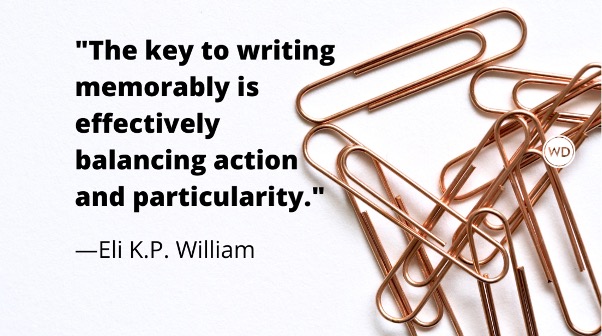
How to Write Vivid Descriptions
“Whenever you go out to paint, try to forget what objects you have in front of you – a tree, a house, a field or whatever. Merely think, here is a little squeeze of blue, here an oblong of pink, here a streak of yellow, and paint it just as it looks to you, until it gives your own naïve impression of the scene in front of you.” – Claude Monet
I first encountered this quote in Oliver Sacks’ book An Anthropologist On Mars. It is advice on how to break free of cliche approaches to painting, but it applies almost just as well to writing.
The first step to vividly describing a place, person, or thing is to imagine it in your mind’s eye. Alternately, if it actually exists you may prefer to look at it or a photograph directly. Either way, you’ll start with some scene before you without dividing it into objects or attaching any words to it. Just form a “naïve impression” of the colors, textures, shapes, feeling, of whatever it is while refraining from your impulse to name them. Simply picture and observe.
The next step is to carefully select the right words to convey it. If the words that come to mind don’t seem adequate, look in a dictionary, ask around, or do some research if necessary, but be sure to keep searching until you have the closest match possible between experience and language. While it’s okay to stop short of perfection, since words and thought inevitably fail to capture perception anyways, keep revising until you can’t think of any way to improve your description further. At this point, your gut instinct should be telling you it’s ready.
What I’ve said so far may sound obvious, but it’s surprising how easy it is to get these two steps mixed up. Instead of allowing the meaning you want to express to decide the words, you are seduced by alliteration, rhythm and other sonic features, or fail to escape from customary phrasing, and allow language itself to decide what it is you want to say. But this approach, as George Orwell cautions in his famous essay Politics And The English Language, traps writers in trite, conformist modes of thinking, which drains their images of vividness.

Examples of How to Write a Vivid Description
So now that we have a basic method, let’s try to describe a lake at sunset: “The lake glittered in the light of the setting sun.”
There is nothing wrong with this sentence. It might work well in many a story depending on the context. But it doesn’t capture the particularity of the moment.
“As the tip of the sun was about to slip below the green hills stretching in layered curves along the horizon, the lake caught its setting light, and glittering streaks of mauve and orange squirmed across the black surface with the undulations of the waves like worms of celestial fire.”
Our second example may be slightly overwrought. The simile at the end adds precision to the image but may carry unwanted symbolic baggage, and we might find other ways to simplify it, but at least it transports the reader’s awareness into the moment. This is not just any sunset on any lake at any time, but the particular phase of a particular sunset on a particular lake. You can see the effort made to envision a definitive scene and give it a commensurately definitive expression.
Balancing Description and Pacing
You’ve probably noticed that the word count for the second example is much higher than the first, so once you’ve become proficient at writing with naïvety, the next point to consider is pacing.
You don’t want to describe everything in meticulous detail all the time as this can overwhelm and potentially bore your reader. Even in my novel Cash Crash Jubilee, in which I set out to describe every moment of my protagonist’s experience over the course of three days, I decided to cut out and simplify many descriptions in the interest of moving the plot along. On the other hand, excessively barebones writing with insufficient detail may get to the action quicker but will deprive the story of originality and impact. This quote from Raymond Chandler, commenting on the way readers react to detective fiction, illustrates this point:
“The things they remembered, that haunted them, was not, for example, that a man got killed, but that in the moment of death he was trying to pick a paper clip up off the polished surface of a desk, and it kept slipping away from him, so that there was a look of strain on his face and his mouth was half opened in a kind of tormented grin, and the last thing in the world he thought about was death.”
Remove the details of the paper clip and the look on the man’s face, and this murder is liable to fade from the reader’s memory like a clear, blue sky. The key to writing memorably is effectively balancing action and particularity. But the ideal balance varies from story to story—with short stories tending to weight action more heavily than novels—and also depends on personal style. In this sense, writing with naïvety is a tool to help you discover what proportion works for you and the stories that only you can tell.
*Originally published on Writer’s Digest
 Eli K.P. William is the author of The Jubilee Cycle trilogy (Skyhorse Publishing), a science fiction trilogy set in a dystopian future Tokyo. He also translates Japanese literature, including the bestselling novel A Man (Crossing) by Keiichiro Hirano, and serves as a writing consultant for a well-known Japanese video game company. His translations, essays, and short stories have appeared in such publications as Granta, The Southern Review, Monkey, and The Malahat Review.
Eli K.P. William is the author of The Jubilee Cycle trilogy (Skyhorse Publishing), a science fiction trilogy set in a dystopian future Tokyo. He also translates Japanese literature, including the bestselling novel A Man (Crossing) by Keiichiro Hirano, and serves as a writing consultant for a well-known Japanese video game company. His translations, essays, and short stories have appeared in such publications as Granta, The Southern Review, Monkey, and The Malahat Review.
More about Eli here.
Follow him on BlueSKy: @elikpwilliam
Or for more essays like this, JOIN ELI’S NEWSLETTER
ALMOST REAL
essays on futurism, philosophy,
speculative fiction, and Japan
by Eli K.P. William
